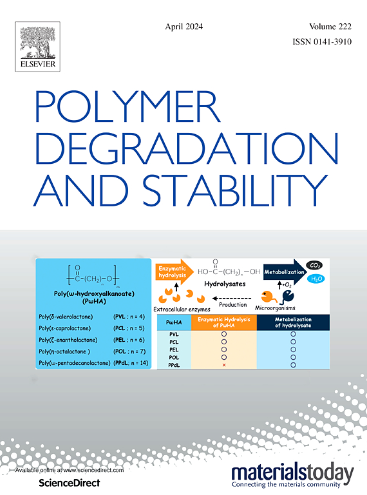含邻苯二腈生物基苯并恶嗪:非溶剂合成、固化行为及热解机理
IF 7.4
2区 化学
Q1 POLYMER SCIENCE
引用次数: 0
摘要
传统的苯并恶嗪在很大程度上受到对不可再生资源的依赖、溶剂型合成和耐热性不足的限制。以丁香酚、3-氨基苯氧基邻苯二腈和多聚甲醛为原料,通过熔融缩合法制备了一种高性能的生物基苯并恶嗪。通过FTIR、¹H和¹³C核磁共振分析验证了BZPN的化学式。BZPN的固化过程包括恶嗪基开环聚合和邻苯二腈基成环聚合,分别生成聚苯并恶嗪和杂芳烃。结合TG-DTG、TG-FTIR和TG-MS技术,提出了BZPN的三段式热裂解机理。初始分解(Tdm1=395℃)发生在聚苯并恶嗪中CN、CO和CC键的裂解,释放出NH₃、H₂O、CH₄和CO₂。第二阶段(Tdm2=485°C)通过释放NH₃、H₂O、CH₄和CO₂来裂解CO和CC键。最后的碳化阶段(Tdm3=615℃)包括高芳香族化合物转化为石墨。生物基BZPN具有简单的无溶剂合成方法和优越的综合性能(抗压强度:>;220 MPa, Tg: >375°C, Td5: >390°C, 800°C时Cy: 72%),是一种有前途的高性能热固性树脂,可用于先进的工业和工程应用。本文章由计算机程序翻译,如有差异,请以英文原文为准。
Bio-based benzoxazine containing phthalonitrile: Nonsolvent synthesis, curing behavior and pyrolysis mechanism
Traditional benzoxazines are largely constrained by the dependence on non-renewable resources, solvent-based synthesis, and insufficient thermal resistance. This study presents a novel high-performance bio-based benzoxazine containing phthalonitrile (BZPN), synthesized via melt condensation using eugenol, 3-aminophenoxyphthalonitrile, and paraformaldehyde. The chemical formula of BZPN was validated by FTIR, ¹H and ¹³C NMR analyses. The curing of BZPN involves ring-opening polymerization of oxazine group and ring-forming polymerization from phthalonitrile unit, yielding polybenzoxazines and heteroaromatics respectively. Combined TG-DTG, TG-FTIR with TG-MS technique, the three-stage thermal pyrolysis mechanism of BZPN was proposed. The initial decomposition (Tdm1=395 °C) occurs through the cleavage of C![]() N, C
N, C![]() O, and C
O, and C![]() C bonds in the polybenzoxazine, releasing NH₃, H₂O, CH₄, and CO₂. The second stage (Tdm2=485 °C) involves the cleavage of C
C bonds in the polybenzoxazine, releasing NH₃, H₂O, CH₄, and CO₂. The second stage (Tdm2=485 °C) involves the cleavage of C![]() O and C
O and C![]() C bonds in the heteroaromatic networks by releasing NH₃, H₂O, CH₄, and CO₂. The final carbonization stage (Tdm3=615 °C) includes the transformation of highly aromatic compounds into graphite. With the facile solvent-less synthesis method and superior comprehensive properties (compressive strength: >220 MPa, Tg: >375 °C, Td5: >390 °C, and Cy: 72 % at 800 °C), bio-based BZPN is a promising high-performance thermosetting resin for advanced industrial and engineering applications.
C bonds in the heteroaromatic networks by releasing NH₃, H₂O, CH₄, and CO₂. The final carbonization stage (Tdm3=615 °C) includes the transformation of highly aromatic compounds into graphite. With the facile solvent-less synthesis method and superior comprehensive properties (compressive strength: >220 MPa, Tg: >375 °C, Td5: >390 °C, and Cy: 72 % at 800 °C), bio-based BZPN is a promising high-performance thermosetting resin for advanced industrial and engineering applications.
求助全文
通过发布文献求助,成功后即可免费获取论文全文。
去求助
来源期刊

Polymer Degradation and Stability
化学-高分子科学
CiteScore
10.10
自引率
10.20%
发文量
325
审稿时长
23 days
期刊介绍:
Polymer Degradation and Stability deals with the degradation reactions and their control which are a major preoccupation of practitioners of the many and diverse aspects of modern polymer technology.
Deteriorative reactions occur during processing, when polymers are subjected to heat, oxygen and mechanical stress, and during the useful life of the materials when oxygen and sunlight are the most important degradative agencies. In more specialised applications, degradation may be induced by high energy radiation, ozone, atmospheric pollutants, mechanical stress, biological action, hydrolysis and many other influences. The mechanisms of these reactions and stabilisation processes must be understood if the technology and application of polymers are to continue to advance. The reporting of investigations of this kind is therefore a major function of this journal.
However there are also new developments in polymer technology in which degradation processes find positive applications. For example, photodegradable plastics are now available, the recycling of polymeric products will become increasingly important, degradation and combustion studies are involved in the definition of the fire hazards which are associated with polymeric materials and the microelectronics industry is vitally dependent upon polymer degradation in the manufacture of its circuitry. Polymer properties may also be improved by processes like curing and grafting, the chemistry of which can be closely related to that which causes physical deterioration in other circumstances.
 求助内容:
求助内容: 应助结果提醒方式:
应助结果提醒方式:


